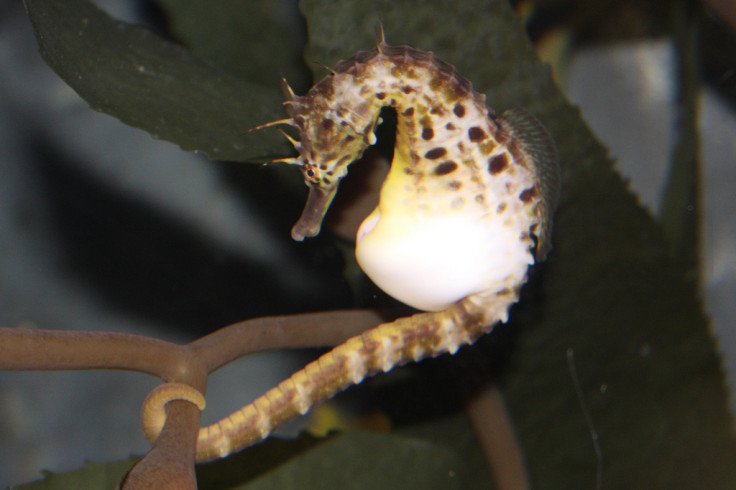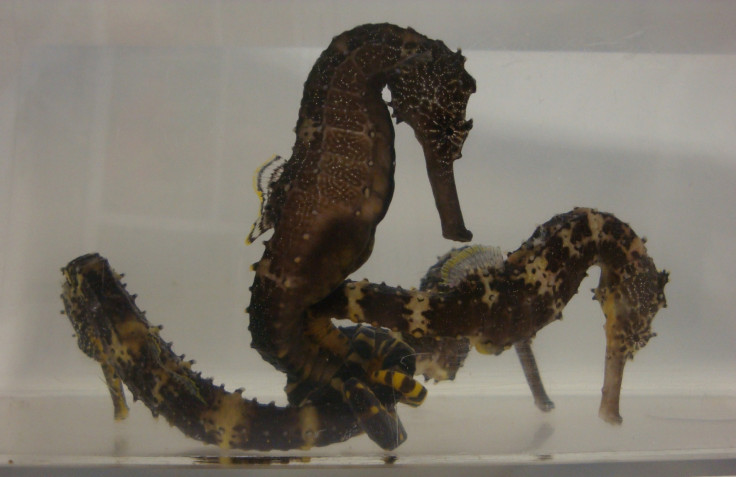Here's how male seahorses ended up being the ones that get pregnant
Evolutionary biologists also reveal why they have no teeth or pelvic fin.
Seahorses are the only known animal where the male gets pregnant and has babies. How they ended up with this unique trait has been a longstanding mystery – one which scientists have now solved by extensively analysing its genome.
Male pregnancy is not the only thing that makes these little sea creatures unusual. They don't have teeth, they don't have a pelvic fin, instead of a ribcage their bodies are covered with bony plates and they swim vertically.
In a study published in Nature, six evolutionary biologists undertook a project to sequence and analyse the genome of the tiger tail seahorse. This allowed them to see which genes and the mechanisms guiding them led the seahorse to become such an oddity.
Male pregnancy

The seahorse fact most people know is that the male gets 'pregnant'. They have a pouch on their fronts into which the female deposits eggs. The male then carries them for up to 45 days, when they emerge fully developed.
In their analysis, the team found a specific gene associated with the hatching of embryos that were highly expressed within the male brood pouch. They found that during seahorse evolution gene duplications likely took place – when this happens, the copy can go on to carry out an entirely new function.
They believe the duplication of the gene gave rise to male pregnancy. They found tandem duplications that led to six genes, the subfamily of which includes the hatching enzyme. Of these six, five are highly expressed in the brood patch – potentially resulting in the rewiring of their regulatory network and "leading to the suggestion that this gene may have a role in the evolution of male pregnancy".
Pelvic fin loss and body armour gain
Seahorses do not have a tail or pelvic fin. The gene responsible for this is tbx4, which is found in almost all vertebrates, but is missing from the genome of the sea horse. To test that this was the one responsible, researchers deactivated the gene in zebrafish. Following the loss, the zebrafish also lost their pelvic bone.

But this loss may have resulted in the seahorse gaining its gripping tail – seahorses tether themselves to plants etc. in order to save energy (they are poor swimmers). They have also evolved bony plates that strengthen it, offering better protection from predators. "The loss of pelvic fins in seahorse is associated with the evolution of an armour-like covering of its body and gain of an elongated, flexible, substrate-gripping tail," the team wrote.
Toothless
Finally the researchers looked at why the seahorse lost its teeth. They have a tubular mouth and chews its prey by sucking it with huge negative pressure generated from its snout. Researchers found seahorses appear to have lost genes for enamel proteins and evolved their tube-like mouths as a result.
It also largely lost the genes responsible for sense of smell – something it does not really need because of its excellent eyesight. Seahorses are able to move their eyes independently of one another.
Researchers say the seahorses unusual morphology shows how genetic changes can lead to evolutionary changes that give it its traits. "Seahorses possess one of the most highly specialised morphologies and reproductive behaviours. We sequenced the genome of the tiger tail seahorse and performed comparative analysis with other teleost fishes. Our genome-wide analysis highlights several aspects that may have contributed to the highly specialised body plan and male pregnancy of seahorses," they conclude.
© Copyright IBTimes 2025. All rights reserved.






















